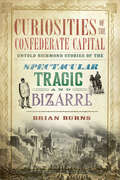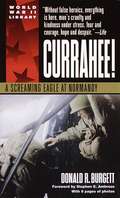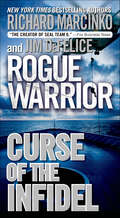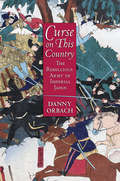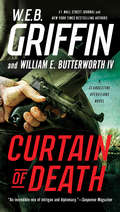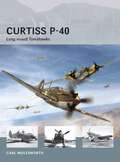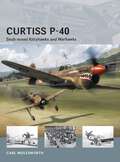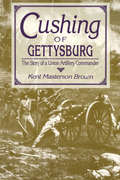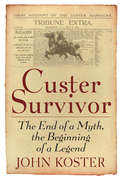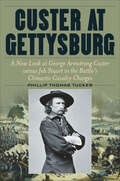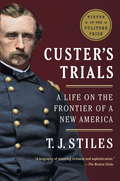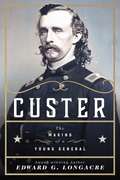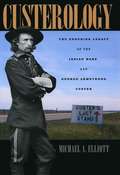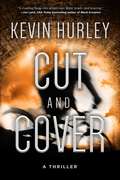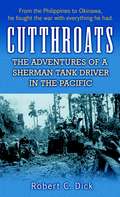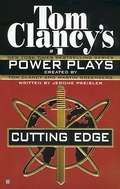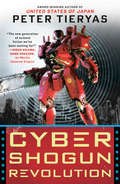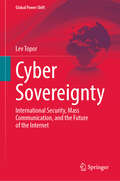- Table View
- List View
Curiosities of the Confederate Capital: Untold Richmond Stories of the Spectacular, Tragic, and Bizarre
by Brian BurnsUncover the secrets of the River City&’s Confederate past. In the early days of the Civil War, Richmond was declared the capital of the Confederacy, and until now, countless stories from its tenure as the Southern headquarters have remained buried. Mary E. Walker, a Union doctor and feminist, was once held captive in the city for refusing to wear proper women&’s clothing. A coffee substitute factory exploded under intriguing circumstances. Many Confederate soldiers, when in the trenches of battle, thumbed through the pages of Hugo&’s Les Miserables. Author Brian Burns reveals these and many more curious tales of Civil War Richmond.
Currahee!: A Screaming Eagle at Normandy
by Donald R. Burgett<p>No other book on D-Day can approach <i>Currahee!</i> Among all the accounts by officers and war correspondents it stands alone: the only account of D-Day by a private soldier who lived through the fighting. <p>Told simply but with total recall, this is the combat narrative of a 19-year-old paratrooper who took part in the momentous invasion of Normandy as a PFC in the 506th Parachute Regiment and fought almost continuously for five days and nights in the battle to secure the beachhead. <p>In <i>Currahee!</i> Burgett tells of killing and heroism, the confusion of war and the shock of death, as he presents his stunning eyewitness account of D-Day--living through an experience he could never forget.</p>
Curse of the Infidel (Rogue Warrior)
by Richard Marcinko Jim DeFeliceHot on the trail of a bank official who is laundering money for an al Qaeda-sponsored terrorist cell, Rogue Warrior Richard Marcinko finds himself in the thick of a covert operation run by the CIA—a.k.a. the Christians in Action. Angry that their operation has been ruined, the CIA demands that Marcinko and his Red Cell International group work for them. He agrees, then gets into a situation so dire only SEAL Team Six can extricate him.While grateful for help from the unit he helped establish, Marcinko realizes there's a lot more going on than the CIA will admit—and when the investigation leads to a luxury liner loaded with explosives and contraband heading toward the United States, he recruits members from the original SEAL Team Six to help. But will the old-timers and young bucks be enough to prevent disaster in a US port?At the Publisher's request, this title is being sold without Digital Rights Management Software (DRM) applied.
Curse on This Country: The Rebellious Army of Imperial Japan
by Danny OrbachImperial Japanese soldiers were notorious for blindly following orders, and their enemies in the Pacific War derided them as "cattle to the slaughter." But, in fact, the Japanese Army had a long history as one of the most disobedient armies in the world. Officers repeatedly staged coups d'états, violent insurrections, and political assassinations; their associates defied orders given by both the government and the general staff, launched independent military operations against other countries, and in two notorious cases conspired to assassinate foreign leaders despite direct orders to the contrary. In Curse on This Country, Danny Orbach explains the culture of rebellion in the Japanese armed forces. It was a culture created by a series of seemingly innocent decisions, each reasonable in its own right, which led to a gradual weakening of Japanese government control over its army and navy. The consequences were dire, as the armed forces dragged the government into more and more of China across the 1930s—a culture of rebellion that made the Pacific War possible. Orbach argues that brazen defiance, rather than blind obedience, was the motive force of modern Japanese history. Curse on This Country follows a series of dramatic events: assassinations in the dark corners of Tokyo, the famous rebellion of Saigō Takamori, the “accidental” invasion of Taiwan, the Japanese ambassador’s plot to murder the queen of Korea, and the military-political crisis in which the Japanese prime minister “changed colors.” Finally, through the sinister plots of the clandestine Cherry Blossom Society, we follow the deterioration of Japan into chaos, fascism, and world wa
Curtain of Death (A Clandestine Operations Novel #3)
by William E. Butterworth W.E.B. GriffinFrom #1 New York Times-bestselling author W. E. B. Griffin comes the dramatic third novel in the Clandestine Operations series about the Cold War, the fledgling Central Intelligence Agency--and a new breed of warrior. January 1946: Two WACs leave an officers' club in Munich, and four Soviet NKGB agents kidnap them at knifepoint in the parking lot and shove them in the back of an ambulance. That is the agents' first mistake, and their last. One of the WACs, a blond woman improbably named Claudette Colbert, works for the new Directorate of Central Intelligence, and three of the men end up dead and the fourth wounded. The "incident," however, will send shock waves rippling up and down the line and have major repercussions not only for her, but for her boss, James Cronley, Chief DCI-Europe, and for everybody involved in their still-evolving enterprise. For, though the Germans may have been defeated, Cronley and his company are on the front lines of an entirely different kind of war now. The enemy has changed, the rules have changed--and the stakes have never been higher.
Curtiss P-40 - Long-nosed Tomahawks
by Carl MolesworthThe initial version of the Curtiss P-40, designated by the manufacturer as the Hawk H-81, combined the established airframe of the earlier radial-powered H-75 (P-36) fighter with the Allison V-1710 liquid-cooled engine. The year was 1939, and the marriage was one of expediency. With the threat of war in Europe growing by the day, the US Army Air Corps brass wanted a modern fighter that would combine the sterling handling qualities of the P-36 with a boost in performance that would make it competitive with the new types emerging in Germany and England, and the generals wanted the new plane immediately. The P-40 delivered admirably, and though it never reached the performance levels of the Bf 109 or Spitfire, the sturdy fighter nevertheless made a place in history for itself as the Army's frontline fighter when the US entered World War II. Long-nosed P-40s initially saw combat in North Africa, flying in Royal Air Force squadrons. They also fought in the skies over Pearl Harbor and the Philippines. But the long-nosed P-40 is best known as the shark-faced fighter flown by the American Volunteer Group - the legendary Flying Tigers - over Burma and China during 1941-42.
Curtiss P-40 -Snub-nosed Kittyhawks and Warhawks
by Carl Molesworth Adam ToobyAn improved version of the Allison V-1710 engine gave rise to the Curtiss H-87, which began life in 1941 as the P-40D and featured a completely redesigned fuselage. The shorter and deeper nose of the new fighter gave it a decidedly snub-nosed appearance compared to the earlier P-40 models. Curtiss continued to tweak the H-87 for the next two years in the search for better performance, but the last major version, the P-40N, was only marginally faster than the first. In the process, Curtiss even tried an engine change to the Packard Merlin in the P-40F and L but to no avail. What the late model P-40s lacked in speed and service ceiling, they traded for maneuverability, durability and availability. Their niche became fighter-bomber operations, and they fought on fronts as varied as the arctic wastes of the Aleutian Islands and Iceland, the steaming jungles of the South Pacific and the barren deserts of North Africa. P-40s were a common sight in the skies over Burma and China, Sicily and Italy, and western Russia as well. By the time production ceased in 1944, Curtiss had produced nearly 14,000 P-40s.
Curveball: Spies, Lies, and the Con Man Who Caused a War
by Bob DroginCurveball answers the crucial question of the Iraq war: How and why was America's intelligence so catastrophically wrong? In this dramatic and explosive book, award-winning Los Angeles Times reporter Bob Drogin delivers a narrative that takes us to Europe, the Middle East, and deep inside the CIA to find the truth about the lies and self-deception that led us into a military and political nightmare.
Curveball: Spies, Lies, and the Con Man Who Caused a War
by Bob DroginCurveball answers the crucial question of the Iraq war: How and why was America's intelligence so catastrophically wrong? In this dramatic and explosive book, award-winning Los Angeles Times reporter Bob Drogin delivers a narrative that takes us to Europe, the Middle East, and deep inside the CIA to find the truth-the truth about the lies and self-deception that led us into a military and political nightmare.
Cushing of Gettysburg: The Story of a Union Artillery Commander
by Kent Masterson BrownThis Civil War biography chronicles the life of the brave Union artillery officer who refused to retreat from Pickett&’s Charge at the Battle of Gettysburg. Lieutenant Alonzo Hereford Cushing may be the most famous lieutenant to be killed during the Civil War. Two years out of West Point, the young artillery officer commanded Battery A of the 4th US Artillery at Gettysburg. Despite severe wounds, Cushing defended his position at Cemetery Ridge against the fearsome Confederate infantry assault. The story of Cushing&’s heroic final moments were witnessed and recorded by a battlefield correspondent for The New York Times, who said &“the gallantry of this officer is beyond praise.&” In 2014, President Barak Obama awarded Cushing a posthumous Medal of Honor. In this biography, Kent Brown presents a lively narrative based on extensive research, including a cache of Cushing&’s letters.
Custer Survivor: The End Of The Myth, The Beginning Of A Legend
by John KosterCuster Survivor was the basis for History Channel's television documentary Custer's Last Stand about the one man in the Seventh Cavalry who escaped the annihilation at the Battle of the Little Big Horn. It is the story of Sgt. Frank Finkel of "C" Company, who, stunned by the impact of a rifle barrel smashing his forehead, was carried off by his panic stricken horse. Drawn from Sioux observations, Dept. of Army documents and forensic evidence, this is the story of the one soldier who escaped death at Little Big Horn and the fascinating life story of the man who turned myth into legend.
Custer at Gettysburg: A New Look at George Armstrong Custer versus Jeb Stuart in the Battle's Climactic Cavalry Charges
by Phillip Thomas Tucker&“A mosaic of thousands of tiny pieces that, seen whole, amounts to a fascinating picture of what probably was the most important moment of the Civil War.&” —Thomas E. Ricks, New York Times bestselling author of The Generals George Armstrong Custer is famous for his fatal defeat at the Little Bighorn in 1876, but Custer&’s baptism of fire came during the Civil War. His true rise to prominence began at Gettysburg in 1863. On the eve of the Battle of Gettysburg, Custer received promotion to brigadier general and command—his first direct field command—of the Michigan Cavalry Brigade, the &“Wolverines.&” Custer did not disappoint his superiors, who promoted him in a search for more aggressive cavalry officers. At approximately noon on July 3, 1863, the melee that was East Cavalry Field at Gettysburg began. An hour or two into the battle, after many of his cavalrymen had been reduced to hand-to-hand infantry-style fighting, Custer ordered a charge of one of his regiments and led it into action himself, screaming one of the battle&’s most famous lines: &“Come on, you Wolverines!&” Around three o&’clock, the Confederates led by Stuart mounted a final charge, which mowed down Union cavalry—until it ran into Custer&’s Wolverines, who stood firm, breaking the Confederates&’ last attack. In a book combining two popular subjects, Tucker recounts the story of Custer at Gettysburg with verve, shows how the Custer legend was born on the fields of the war&’s most famous battle, and offers eye-opening new perspectives on Gettysburg&’s overlooked cavalry battle. &“A thoughtful and challenging new look at the great assault at Gettysburg . . . Tucker is fresh and bold in his analysis and use of sources.&” —William C. Davis, author of Crucible of Command
Custer's Trials: A Life on the Frontier of a New America
by T. J. StilesWinner of the 2016 Pulitzer Prize for HistoryFrom the winner of two Pulitzer Prizes and a National Book Award, a brilliant biography of Gen. George Armstrong Custer that radically changes our view of the man and his turbulent times.In this magisterial biography, T. J. Stiles paints a portrait of Custer both deeply personal and sweeping in scope, proving how much of Custer's legacy has been ignored. He demolishes Custer's historical caricature, revealing a volatile, contradictory, intense person--capable yet insecure, intelligent yet bigoted, passionate yet self-destructive, a romantic individualist at odds with the institution of the military (he was court-martialed twice in six years). The key to understanding Custer, Stiles writes, is keeping in mind that he lived on a frontier in time. In the Civil War, the West, and many areas overlooked in previous biographies, Custer helped to create modern America, but he could never adapt to it. He freed countless slaves yet rejected new civil rights laws. He proved his heroism but missed the dark reality of war for so many others. A talented combat leader, he struggled as a manager in the West. He tried to make a fortune on Wall Street yet never connected with the new corporate economy. Native Americans fascinated him, but he could not see them as fully human. A popular writer, he remained apart from Ambrose Bierce, Mark Twain, and other rising intellectuals. During Custer's lifetime, Americans saw their world remade. His admirers saw him as the embodiment of the nation's gallant youth, of all that they were losing; his detractors despised him for resisting a more complex and promising future. Intimate, dramatic, and provocative, this biography captures the larger story of the changing nation in Custer's tumultuous marriage to his highly educated wife, Libbie; their complicated relationship with Eliza Brown, the forceful black woman who ran their household; as well as his battles and expeditions. It casts surprising new light on a near-mythic American figure, a man both widely known and little understood.From the Hardcover edition.
Custer: The Controversial Lie of George Armstrong Custer
by Jeffry D. WertGeorge Armstrong Custer has been so heavily mythologized that the human being has been all but lost. Now, in the first complete biography in decades, Jeffry Wert reexamines the life of the famous soldier to give us Custer in all his colorful complexity. Although remembered today as the loser at Little Big Horn, Custer was the victor of many cavalry engagements in the Civil War. He played an important role in several battles in the Virginia theater of the war, including the Shenandoah campaign. Renowned for his fearlessness in battle, he was always in front of his troops, leading the charge. His men were fiercely loyal to him, and he was highly regarded by Sheridan and Grant as well. Some historians think he may have been the finest cavalry officer in the Union Army. But when he was assigned to the Indian wars on the Plains, life changed drastically for Custer. No longer was he in command of soldiers bound together by a cause they believed in. Discipline problems were rampant, and Custer's response to them earned him a court-martial. There were long lulls in the fighting, during which time Custer turned his attention elsewhere, often to his wife, Libbie Bacon Custer, to whom he was devoted. Their romance and marriage is a remarkable love story, told here in part through their personal correspondence. After Custer's death, Libbie would remain faithful to his memory until her own death nearly six decades later. Jeffry Wert carefully examines the events around the defeat at Little Big Horn, drawing on recent archeological findings and the latest scholarship. His evenhanded account of the dramatic battle puts Custer's performance, and that of his subordinates, in proper perspective. From beginning to end, this masterful biography peels off the layers of legend to reveal for us the real George Armstrong Custer.
Custer: The Life of General George Armstrong Custer
by Jay Monaghan"The best book yet written about Custer and the full significance of his career. . . . Deserves a medal of honor for extraordinary service in the great cause of making history live."—Chicago Tribune
Custer: The Making of a Young General
by Edward G. LongacreThe name George Armstrong Custer looms large in American history, specifically for his leadership in the American Indian Wars and unfortunate fall at the Battle of Little Bighorn. But before his time in the West, Custer began his career fighting for the Union in the Civil War. In Custer: The Making of a Young General, legendary Civil War historian Edward G. Longacre provides fascinating insight into this often-overlooked period in Custer's life. In 1863, under the patronage of General Alfred Pleasonton, commander of the Army of the Potomac's horsemen, a young but promising twenty-three-year-old Custer rose to the unprecedented rank of brigadier general and was placed in charge of the untried Michigan Calvary Brigade. Although over time Custer would bring out excellence in his charges, eventually leading the Wolverines to prominence, his first test came just days later at Hanover, then Hunterstown, and finally Gettysburg. In these campaigns and subsequent ones, Custer's reputation for surging ahead regardless of the odds (almost always with successful results that appeared to validate his calculating recklessness) was firmly established. More than just a history book, Custer: The Making of a Young General is a study of Custer's formative years, his character and personality; his attitudes toward leadership; his tactical preferences, especially for the mounted charge; his trademark brashness and fearlessness; his relations with his subordinates; and his attitudes toward the enemy with whom he clashed repeatedly in Pennsylvania and Virginia. Custer goes into greater depth and detail than any other study of Custer's Civil War career, while firmly refuting many of the myths and misconceptions regarding his personal life and military service. Fascinating and insightful, it belongs on the shelf of every history buff.
Custerology: The Enduring Legacy of the Indian Wars and George Armstrong Custer
by Michael A. ElliottA look at Custer the man, and how the Battle of the Little Bighorn has been retold into history... over and over again. Who has rights to tell the ONE correct side? Is the white version "right", even if the Native American version - with the eyewitness - tells the whites have it wrong? Read about how the history is bring told today, what each version says... You decide - which is right?
Cut and Cover: A Thriller
by Kevin Hurley"A resounding character study just as much as it is an action novel, and both are equally triumphant.” -Kirkus ReviewsTo most people, Maj. John Rexford is a retired Marine living in the Catskill Mountains of New York on disability. Even John’s girlfriend, Maggie, has no idea he’s really a CIA spook recruited in Afghanistan and assigned to kill enemies on US soil.With exemplary skills in hand-to-hand combat and small arms weaponry, John Rexford completes a string of successful kills, eliminating terrorists and their money supply in the New York Metropolitan area. With the FBI hot on his trail for these illegal assassinations, John must find a way to stop an international team of explosives experts from destroying New York City’s aqueducts, killing thousands with chlorine gas, and burning the five boroughs to the ground. During his mission, John runs afoul of a high level underworld assassin who uses his mastery of yoga to silently strangle his victims. When the assassin discovers John’s one liability-his girlfriend, Maggie-John will have to make a terrible choice between her life and the capture of her abductor.This tightly scripted story begins with a terrorist plot and gradually turns into a clash between two professional killers, with the lives of both John Rexford and Maggie hanging in the balance. As the characters collide with deadly force on the streets of New York in Cut and Cover, the line between right and wrong blurs, long-standing loyalties are questioned, and no one is really sure, even if they succeed, what the final outcome will be.Skyhorse Publishing, as well as our Arcade, Yucca, and Good Books imprints, are proud to publish a broad range of books for readers interested in fiction-novels, novellas, political and medical thrillers, comedy, satire, historical fiction, romance, erotic and love stories, mystery, classic literature, folklore and mythology, literary classics including Shakespeare, Dumas, Wilde, Cather, and much more. While not every title we publish becomes a New York Times bestseller or a national bestseller, we are committed to books on subjects that are sometimes overlooked and to authors whose work might not otherwise find a home.
Cutter: A Fight or Flight Novel
by Ashley SuzanneAshley Suzanne follows up Raven with the next round in her scorching Fight or Flight series--the story of a damaged MMA fighter from the wrong side of the tracks, and the sizzling affair that forces him to grow up.Cutter Greer lives at the gym--literally. Abandoned by his parents as a teen, Cutter dropped out of high school and ended up on the streets. In a simple act of kindness, mixed martial arts trainers Garrett and Rian put him up in the apartment above their gym. Now he's got a surrogate family and a shot at MMA stardom--but he still has a lot to learn about women. And he certainly isn't prepared for the earth-shattering consequences that desire can bring. Josette Morelli believes that she and Cutter have something special--more special than just being hot in bed. So when Cutter is scouted to go big time, the thought of being left behind scares her. And then Josette learns a shattering truth that could change everything between her and Cutter . . . unless she learns to set him free. Instead, she tells a lie that destroys their chances at happiness--and forces them both to fight for a future neither knew was possible. Praise for Ashley Suzanne's Raven "Holy crap, Ashley Suzanne completely blew me away with this book. All I'm saying is 'Read this book!' It's fantastic."--USA Today bestselling author Erin Noelle "Ashley Suzanne shows her range in Raven with a totally original plot line full of twists and turns."--New York Times bestselling author S.E. Hall "Ashley Suzanne hits it out of the park with this book. I could talk about how incredible it is all day long. Just go read it. Now."--K.D. Sarks, author of Unexpected Change Includes a special message from the editor, as well as an excerpt from another Loveswept title.
Cutthroats: The Adventures of a Sherman Tank Driver in the Pacific
by Robert DickSoon after we landed it became apparent that there was more than enough artillery here, that the enemy were excellent shots, and that their ammo supply seemed to be endless. With the Japanese deeply entrenched and determined to die rather than surrender, Robert Dick and his fellow soldiers quickly realized that theirs would be a war fought inch by bloody inch and that their Sherman tanks would serve front and center. As driver, Dick had to maneuver his five-man crew in and out of dangerous and often deadly situations. Whether crawling up beaches, bogged down in the mud-soaked Leyte jungle, or exposed in the treacherous valleys of Okinawa, the Sherman was a favorite target. A land mine could blow off the tracks, leaving its crew marooned and helpless, and the nightmare of swarms of Japanese armed with satchel charges was all too real. But there was a war to be won, and Americans like Robert Dick did their jobs without fanfare, and without glory. This gripping account of tanker combat is a ringing testament to the awe-inspiring bravery of ordinary Americans.
Cutting Edge (Tom Clancy's Power Plays #6)
by Tom Clancy Martin H. Greenberg Jerome PreislerWIRED.<P> Africa becomes the battle ground in 21st-century war. As fiberoptic cable is laid down around the continent, two entities fight to control it. One is UpLink Communications, headed by Roger Gordian. The pan-African fiberoptic ring is his most ambitious--and expensive--endeavor to date. His nemesis, Harlan Devane, is penetrating the network. Trading in black market commodities with terrorists and rogue states, the cable offers him unlimited access to a most valuable product: information. To ensure his success, Devane makes his move halfway around the world. He hits Gordian where it hurts--and kidnaps his daughter. Now, Gordian must trust his UpLink team as never before, as they fight on land and sea to turn the tables against Devane...once and for all.
Cutting the Fuse: The Explosion of Global Suicide Terrorism and How to Stop It
by Robert A. Pape Feldman James K.Cutting the Fuse offers a wealth of new knowledge about the origins of suicide terrorism and strategies to stop it. Robert A. Pape and James K. Feldman have examined every suicide terrorist attack worldwide from 1980 to 2009, and the insights they have gleaned from that data fundamentally challenge how we understand the root causes of terrorist campaigns today--and reveal why the War on Terror has been ultimately counterproductive. Through a close analysis of suicide campaigns by Al Qaeda and other terrorist organizations in Iraq, Afghanistan, Pakistan, Lebanon, Israel, Chechnya, and Sri Lanka, the authors provide powerful new evidence that, contrary to popular and dangerously mistaken belief, only a tiny minority of these attacks are motivated solely by religion. Instead, the root cause is foreign military occupation, which triggers secular and religious people alike to carry out suicide attacks. Cutting the Fuse calls for new, effective solutions that America and its allies can sustain for decades, relying less on ground troops in Muslim countries and more on offshore, over-the-horizon military forces along with political and economic strategies that empower local communities to stop terrorists in their midst.
Cyber Shogun Revolution (A United States of Japan Novel #3)
by Peter TieryasThe Man in the High Castle meets Pacific Rim in this action-packed alternate history novel from the award-winning author of United States of Japan and Mecha Samurai Empire.NO ONE SURVIVES AN ALLIANCE WITH THE NAZIS. NOT WITHOUT USE OF FORCE.Seattle, 2019. After a severe injury, ace mecha designer and pilot Reiko Morikawa is recruited to a secret organization plotting a revolt against the corrupt governor (and Nazi sympathizer) of the United States of Japan. When their plan to save the USJ from itself goes awry, the mission is only saved from failure because the governor is killed by an assassin known as Bloody Mary. But the assassin isn't satisfied with just the governor.Bishop Wakana used to be a cop. Now he's an agent of the Tokko, the secret police. Following the trail of a Nazi scientist, Bishop discovers a web of weapons smuggling, black market mecha parts--and a mysterious assassin. This killer once hunted Nazis but now seems to be targeting the USJ itself. As the leaders of the United States of Japan come to realize the devil's bargain they made in their uneasy alliance with the Nazis, Bishop and Reiko are hot on the trail of Bloody Mary, trying to stop her before it's too late.
Cyber Sovereignty: International Security, Mass Communication, and the Future of the Internet (Global Power Shift)
by Lev ToporThe internet has become a battleground for global power struggles, with nations and even terrorist organizations wielding cyber-attacks to exert control. As the absence of binding international laws and norms leaves cyberspace largely unchecked, countries are seeking to establish their Sovereign Cyber Domains (SCD) - tightly controlled cyberspaces. In this illuminating monograph, the author explores how Russia, China, Iran, and others perceive the internet as a means for the United States and its allies to maintain global dominance and influence foreign audiences, driving their pursuit of strict regulations over domestic cyber affairs and mass communication. Yet, even the United States is now susceptible to foreign cyber operations, mainly foreign influence that undermines its domestic affairs. Even International Blocs like the European Union had expressed concerns about foreign influence and privacy rights abuses, leading to regulatory initiatives like the General Data Protection Regulation, Digital Services Act and the Digital Markets Act. As nations prioritize cybersecurity and sovereignty over free speech and convenience, the book predicts a future of increased regulation across all layers of the cyber domain, mirroring the historical emergence of the concept of sovereignty.Drawing on a combination of political science, international relations, and cyber domain practices, this monograph offers valuable insights for policymakers, practitioners, researchers, and students. By analyzing existing cyber sovereignty processes and predicting future trends, the book contributes to international relations theories, sheds light on the challenges of an unregulated cyber domain, and provides guidance for a secure and controlled digital future.
Cyber War: The Next Threat to National Security and What to Do About It
by Richard A. Clarke Robert KnakeRichard A. Clarke warned America once before about the havoc terrorism would wreak on our national security--and he was right. Now he warns us of another threat, silent but equally dangerous. Cyber War is a powerful book about technology, government, and military strategy; about criminals, spies, soldiers, and hackers. This is the first book about the war of the future--cyber war--and a convincing argument that we may already be in peril of losing it. Cyber War goes behind the "geek talk" of hackers and computer scientists to explain clearly and convincingly what cyber war is, how cyber weapons work, and how vulnerable we are as a nation and as individuals to the vast and looming web of cyber criminals. From the first cyber crisis meeting in the White House a decade ago to the boardrooms of Silicon Valley and the electrical tunnels under Manhattan, Clarke and coauthor Robert K. Knake trace the rise of the cyber age and profile the unlikely characters and places at the epicenter of the battlefield. They recount the foreign cyber spies who hacked into the office of the Secretary of Defense, the control systems for U.S. electric power grids, and the plans to protect America's latest fighter aircraft. Economically and militarily, Clarke and Knake argue, what we've already lost in the new millennium's cyber battles is tantamount to the Soviet and Chinese theft of our nuclear bomb secrets in the 1940s and 1950s. The possibilities of what we stand to lose in an all-out cyber war--our individual and national security among them-- are just as chilling. Powerful and convincing, Cyber War begins the critical debate about the next great threat to national security.
